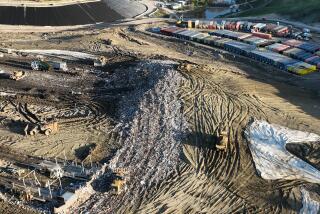Methane Leak Poses No Danger, Officials Say
Monitoring of methane gas at two Wilmington landfills has determined that the gas is leaking in such small amounts that it poses no hazard to a nearby residential neighborhood, Los Angeles city officials said Wednesday.
The Bureau of Sanitation reported Wednesday that 18 probes installed in November outside homes on Sandison Street between Sanford Street and Blinn Avenue detected insignificant levels of the potentially explosive gas, which usually is formed at landfills by the decomposition of vegetation.
“The results gathered show that although gas is migrating from the (landfill) at high levels, up to 50% methane, these levels are reduced to less than .075% at the residents’ property boundary,” the bureau reported at a meeting of the Board of Public Works. “The potential for any hazard associated with these low levels of methane gas is negligible.”
In September, the board directed owners of the Beeco and Desser landfills to place 3-foot-deep probes on a city-owned grassy strip near three dozen homes across the street from the dumps. At that time, sanitation officials said no methane gas was leaking at ground level near the homes, but they feared that the gas might be migrating underground.
The tests were conducted weekly beginning Nov. 12, and although they did not reveal a methane gas problem, city officials said the monitoring will continue as a precaution.
Sheila C. Molyneux, who has overseen the methane monitoring for the city, said owners of both landfills are designing and installing new gas collection and migration-control systems that will include flares for the disposal of collected gas. The Desser system should be completed within several months, and the Beeco system should be in place by the end of the year, she said.
Both landfills, which no longer accept solid wastes, have systems in place for controlling gas, but Molyneux said they are outdated and no longer adequate.
At its meeting Wednesday, the Board of Public Works authorized consultants for the Beeco landfill to install monitoring probes on city-owned land in front of the landfill. Beeco needs the probes to determine what kind of collection system to build, and city sanitation officials said they would also like to use the probes to monitor Beeco’s progress in controlling the gas.
A spokeswoman for Councilwoman Joan Milke Flores, who represents Wilmington, said none of the neighbors in the area have complained about methane gas from the landfill. Molyneux said the Bureau of Sanitation sent letters to residents about the tests but received no complaints.
Sanitation officials discovered the methane gas problem during routine inspections of the landfills. Wilmington has numerous closed landfills that require regular monitoring by the city, particularly because of the hazards methane gas can pose, Molyneux said. The odorless gas, known as marsh gas because it is commonly created when vegetable matter decomposes in swampy land, becomes highly explosive when mixed with air.
More to Read
Sign up for Essential California
The most important California stories and recommendations in your inbox every morning.
You may occasionally receive promotional content from the Los Angeles Times.










